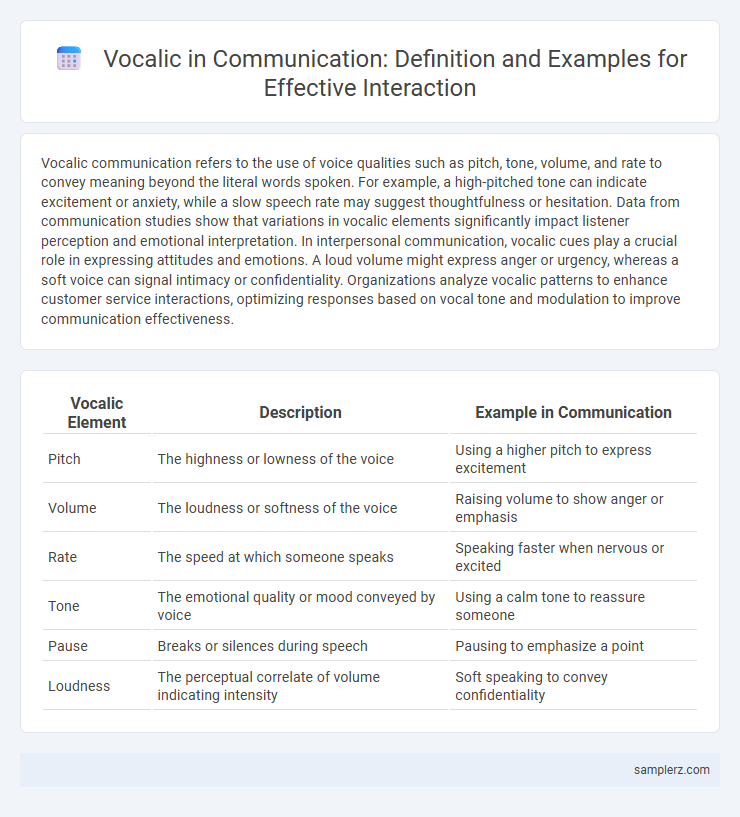Vocalic communication refers to the use of voice qualities such as pitch, tone, volume, and rate to convey meaning beyond the literal words spoken. For example, a high-pitched tone can indicate excitement or anxiety, while a slow speech rate may suggest thoughtfulness or hesitation. Data from communication studies show that variations in vocalic elements significantly impact listener perception and emotional interpretation. In interpersonal communication, vocalic cues play a crucial role in expressing attitudes and emotions. A loud volume might express anger or urgency, whereas a soft voice can signal intimacy or confidentiality. Organizations analyze vocalic patterns to enhance customer service interactions, optimizing responses based on vocal tone and modulation to improve communication effectiveness.
Table of Comparison
| Vocalic Element | Description | Example in Communication |
|---|---|---|
| Pitch | The highness or lowness of the voice | Using a higher pitch to express excitement |
| Volume | The loudness or softness of the voice | Raising volume to show anger or emphasis |
| Rate | The speed at which someone speaks | Speaking faster when nervous or excited |
| Tone | The emotional quality or mood conveyed by voice | Using a calm tone to reassure someone |
| Pause | Breaks or silences during speech | Pausing to emphasize a point |
| Loudness | The perceptual correlate of volume indicating intensity | Soft speaking to convey confidentiality |
Understanding Vocalics in Communication
Vocalics in communication refers to the use of voice qualities such as pitch, tone, volume, and speech rate to convey meaning and emotions beyond words. Variations in vocalics can significantly impact listener perception, influencing attitudes and comprehension during conversations. Mastering vocalic elements enhances effective communication by clearly expressing intent and reinforcing the spoken message.
The Role of Tone in Vocalic Expression
Tone plays a crucial role in vocalic communication by conveying emotions, attitudes, and intentions beyond the literal meaning of words. Variations in pitch, volume, and intonation help listeners interpret sarcasm, urgency, or sincerity, significantly impacting the effectiveness of the message. Effective use of tone enhances interpersonal understanding and reduces potential miscommunication in both personal and professional interactions.
Volume as a Vocalic Cue
Volume serves as a critical vocalic cue in communication by influencing how messages are perceived and interpreted. Speaking at a high volume can convey urgency, confidence, or anger, while a lower volume often indicates calmness, intimacy, or hesitation. Changes in volume help regulate conversational dynamics and emphasize key points to enhance overall message clarity.
Pitch Variation and Its Impact
Pitch variation plays a crucial role in vocalic communication by conveying emotions and emphasizing key messages. Higher pitch often signals excitement or urgency, while lower pitch can indicate seriousness or calmness, affecting listener perception and engagement. Effective modulation of pitch enhances clarity and helps avoid misunderstandings in verbal interactions.
Speaking Rate and Communication Clarity
Speaking rate significantly impacts communication clarity by affecting how listeners perceive and process spoken information. A moderate speaking rate enhances understanding, while excessively fast or slow speech can cause confusion or disengagement. Effective vocalic control, including pacing and intonation, ensures message clarity and listener retention.
Pauses and Their Communicative Significance
Pauses in vocalic communication serve as powerful tools to emphasize key points, regulate the flow of conversation, and convey emotions such as hesitation or confidence. Strategic silence can create suspense or allow listeners time to process information, enhancing overall message clarity. Research shows that well-timed pauses increase listener engagement and improve the effectiveness of verbal interactions.
Emphasis and Stress in Vocalic Delivery
Emphasis and stress in vocalic delivery play a crucial role in communication by altering the meaning and emotional tone of spoken words. Variations in pitch, volume, and duration highlight key ideas, making the message more impactful and easier to understand. Effective vocalic stress enhances listener engagement and clarifies the speaker's intent without changing the actual words used.
Vocalics in Expressing Emotions
Vocalics, also known as paralanguage, play a crucial role in expressing emotions through variations in pitch, tone, volume, and speech rate. For instance, a raised pitch and increased volume often convey excitement or anger, while a slow speech rate and low tone can indicate sadness or fatigue. These vocal cues enhance the emotional meaning behind spoken words, making communication more effective and nuanced.
Cultural Differences in Vocalic Communication
Vocalic communication varies significantly across cultures, influencing tone, pitch, and volume during conversations. For instance, East Asian cultures often prefer softer tones and controlled pitch to express respect, while Mediterranean cultures typically use louder volume and dynamic intonation to convey enthusiasm. Understanding these vocalic differences is crucial for effective intercultural communication and minimizing misunderstandings.
Vocalics in Virtual Versus Face-to-Face Interactions
Vocalics in virtual communication often rely heavily on tone, pitch, and speech rate as nonverbal cues are limited compared to face-to-face interactions, where vocal inflections combine with facial expressions and gestures to convey meaning. In virtual meetings, voice modulation becomes crucial for maintaining engagement and expressing emotions, compensating for the absence of physical presence. Research shows that effective vocalic cues in video calls improve message clarity and interpersonal connection, highlighting the adaptive role of vocalics across communication contexts.

example of vocalic in communication Infographic
 samplerz.com
samplerz.com